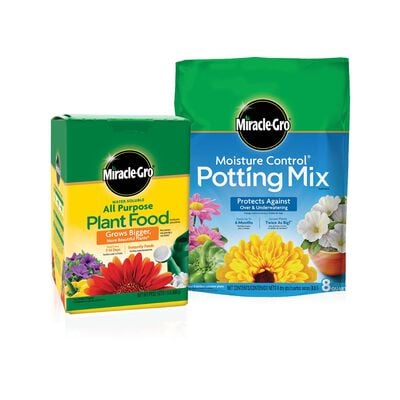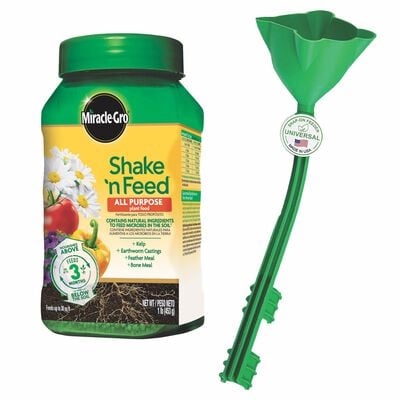
Grow Your Groceries
Easy to grow and easy on the wallet?
Raise your hand if you've purchased a bunch of herbs or a big bag of greens, used a few, then discovered the rest turned to mush in the back of the fridge weeks later. We get it! Food waste happens to even the best planners. But you can reduce the sting of throwing away spoiled—not to mention expensive—produce by growing it yourself.
With a few seed packets and a little know-how, you can save big on the costliest veggies, fruits, and herbs. You'll be able to harvest just the amount you need while cutting down on wasted food and cash. Plus, you can reduce your carbon footprint by taking the notion of "eating local" to a whole new level. Here's how to pick the best money-saving produce to grow in your garden (plus our top recs!)
Pick Plants Wisely
Selecting what to grow will be easy if you keep these 5 tips in mind:
● Grow what you love. It's fun to experiment with new varieties. But if your goal is to save cash, grow foods you and your family will actually eat.
● Opt for pricier produce. Sure, homegrown potatoes may taste better than store-bought, but they won't benefit your wallet as much as growing the more expensive veggies that drive up your grocery bill.
● Grow for your zone. Yes, your beloved guac is pricey, there's not much point in planting an avocado tree if it will never bear fruit. Learn your
USDA plant hardiness zone and stick to plants that will perform well there.● Aim for efficiency. Some plants can take an entire growing season to produce a harvest (looking at you, Brussels sprouts), while others speed from seed to plate in a matter of weeks. Opt for plants that produce a bumper crop in short order.
● Use space smartly. If you're going to grow a plant that takes up a lot of real estate in the garden, make sure it's one that's going to give you a generous harvest in return—not, for example, a single head of broccoli.
Set Your Plants Up for Success
Before you embark on your budget-savvy gardening adventure, ensure you've figured out a few critical elements to maximize your return on investment.
● The perfect location: Most veggies and herbs require full sun, meaning they're in direct light for at least six hours per day. If you lack space for a traditional garden, consider growing in containers on a deck or balcony. Plus, make sure you have easy access to H2O.
● Quality soil: Spoiler alert: The soil in your yard is probably low quality, either because builders hauled away the nutrient-rich topsoil during construction or because it has become depleted of nutrients over time. To prep for fast-growing plants, improve your existing soil with premium-quality
Miracle-Gro® Garden Soil for Vegetables & Herbs or use Miracle-Gro® Potting Mix to ensure container-grown plants have the ideal nutrition and drainage.● Nutrient-rich plant food: In addition to good soil, hungry new plants require extra nutrients to grow strong and vigorous. Feed while you water (time-saver!) with
Miracle-Gro® Water Soluble Plant Food for Vegetables & Herbs, making sure to follow directions.Need more help? Browse our entire library of gardening basics!
Best Plants for Your Buck
These 11 veggies, herbs, and fruits (listed in alphabetical order) are our top picks for saving money by growing your own. We've included rough estimates of how many of each you'll want to plant per person in your family (who will eat that particular food), but you know them best, so use your judgment.
Growing from seedis the most inexpensive way to start, but if you're short on time, strong, vigorous plants like those from Bonnie Plants® are another good option.
1. Arugula
A small bag of this zesty salad green can set you back several dollars, but you can grow it all season long for a fraction of the price. Plant seeds after the threat of frost has passed in your area, then sow new seeds every 2 to 3 weeks, so you always have a fresh batch ready to harvest. Aim for a couple of plants per person to top pizzas and other dishes; bump it up to 5 per person if you plan to make lots of hearty salads.
2. Basil
Skip the tiny plastic containers of fresh basil at the store and snip straight from the plant as you need it. Don't plant this warm-weather herb outside until about 2 weeks after your last frost. Expect to harvest about a half cup per plant per week. One to 4 plants per person (depending on how much you use) will give you a summer's worth of bright basil flavor.
3. Cilantro
Top tacos or whip up fresh salsa anytime with your very own cilantro plants. Cilantro grows best in cooler weather then bolts (which means it has a big growth spurt during which leaves turn bitter) in midsummer heat. With this in mind, you can start seeds about a month before your last frost date in the South and Southwest, but hold off until after your last frost in the North. A single cilantro plant will only give you enough for garnish, so for a steady supply, plant 1 or 2 plants per person every two weeks until early summer. You can start a second round in late summer, which will flourish in the fall. Plants also produce seeds—a.k.a. coriander—that you can add to your spice rack.
4. Green Beans
Kid-favorite green beans produce steadily throughout the summer. Plus, their large seeds are easy to plant, making them a great way to let little ones get in on the grocery-growing action. Wait until after the last frost, then watch seedlings sprout in just a handful of days. You'll need roughly 10 plants per person for a steady supply of side dishes.
5. Kale
Kale thrives in cool weather, so plan to grow it about a month before your last frost date in the spring, then again about 6 weeks before your first frost date in the fall. Grow 3 to 5 plants per person for salads and green smoothies on demand.
6. Lettuce
Just a handful of tiny lettuce seeds can transform into a season's worth of delicious salads. Lettuce dislikes the dog days of summer, so start direct sowing 2 weeks before your area's last frost date, then start up again about 8 weeks before the first frost for a round of fall lettuce. There are many different sizes of lettuce, but in general, grow about 3 straight-line feet of lettuce per person to keep your salad bowls filled.
7. Radishes
These tangy, tiny veggies are ready to harvest just a month after planting—perfect for impatient gardeners. Plant your first crop of radishes as soon as you can work the soil in early spring, then sow a fresh batch of seeds every couple of weeks until summer weather hits its stride. Begin planting again about 6 weeks before your first frost date for a fall harvest. One radish seed equals one ripe radish, so go for roughly 15 radish plants per person, planted every 2 weeks.
8. Parsley
Imagine being able to walk to your back patio every evening and snip a few fresh sprigs to garnish your plate for pennies on the dollar compared to store-bought. Parsley seeds can be slower to germinate than many other homegrown herbs, so this could be a good opportunity to begin with a ready-to-go starter parsley plant. Individual parsley plants are usually on the small side (under 2 feet tall), so we suggest 2 curly or 1 flat-leaf plant per person for just the right amount of garnish-y goodness.
9. Spinach
Ideal for small spaces and smoothie lovers alike, homegrown spinach can provide enough produce to make a noticeable dent in your grocery bill in spring and fall. Plant seeds in spring (spinach does just fine with a little frost) and again in late summer. You can expect roughly 25 spinach leaves per plant—with that in mind, plant 10 to 15 plants per person.
10. Strawberries
If you feel like you could take out a second mortgage to support your berry-buying habit (no judgment here), it's probably worth your while to grow strawberries at home. Opt for an everbearing variety like Quinault, which will give you 2 or 3 generous harvests throughout the summer. This is one plant you probably don't want to start from seed—instead, choose either a bare-root or starter plant. Be sure to follow your particular variety's plant tag for care instructions. Grow 7 to 10 plants per person (more if you want to freeze or preserve any extras), keeping in mind that the average plant produces only 2 or 3 berries per week.
11. Tomatoes
If you ask us, no summer garden is complete without at least one plant loaded with sun-ripened tomatoes. Opt for a compact variety like Husky Red Cherry Tomato, which offers high yields in a container or small garden. One cherry tomato plant should cover the average family, but we fully support growing more—and larger!—tomatoes if space allows.
Now you know how—and what—to plant to grow your groceries. Your wallet and the planet will benefit, while you'll enjoy growing a portion of your food right at home. Get ready to save on everything from garnishes to salads and smoothies!


